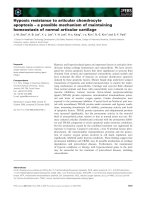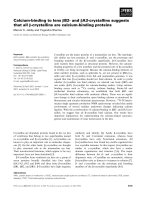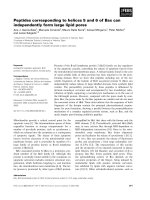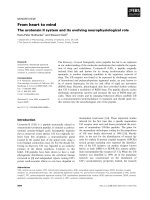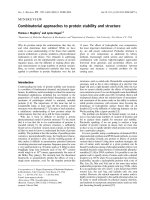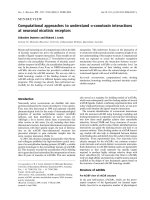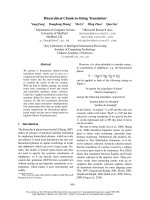báo cáo khoa học: " Shared pathways to infectious disease susceptibility?" ppt
Bạn đang xem bản rút gọn của tài liệu. Xem và tải ngay bản đầy đủ của tài liệu tại đây (259.5 KB, 4 trang )
Introduction
Many severe diseases resulting from infections, such as
meningitis, dengue, or leprosy, are relatively rare within
the human population when compared with the often
ubiquitous nature of the causative infectious agent in
specific world regions. While antibody responses to these
organisms can be measured in large percentages of these
populations, disease leading to hospitalization affects a
small minority. is has led to the realization that the
type of host response made to an infectious encounter
may play a large role in determining the outcome.
Understanding how most people successfully contain
these infectious challenges may lead to the development
of novel therapeutics for those individuals at risk of
severe disease.
is application of human genetics has proven insight-
ful in those rare humans who are broadly susceptible to
infections, where Mendelian genetic linkage approaches
have revealed highly penetrant mutations that cause
disease. With the advent of genome-wide association
study (GWAS) technology, the field has been looking to
see if the lessons learnt can be carried over to more
common infectious diseases.
Severe combined immune deciency and partial
immune deciency
e first studies of immune response defects and infec-
tious disease outcomes strongly suggested that infectious
diseases would have shared pathways to disease. Severe
combined immune deficiency (SCID) - a genetic disorder
that affects the adaptive immune system - demonstrates
the importance of the immune system in protection
against infection, as patients with SCID quickly succumb
to life-threatening sepsis from a very wide range of
infectious agents. e gene responsible for the majority
of SCID cases, CD132 (the common γ-chain), was
identified using the traditional linkage approach [1-3].
Because the common γ-chain is shared by many cytokine
receptors (receptors for IL-2, IL-4, IL-7, IL-9, IL-15, and
IL-21), mutations that result in a non-functional common
γ-chain cause widespread defects in IL signaling and
failure of B and T cells to develop and mature. is is a
rather profound example, and knowledge of the respon-
sible gene has opened avenues for therapeutic inter ven-
tion in cases of X-linked SCID, where gene transfer of the
normal CD132 appears to be a promising, even curative,
treatment modality [4,5]. Similar observations and
clinical conclusions have been made with another form
of SCID caused by defects in the variable, diversity,
joining recombination process [6].
Partial immune deficiency, referring to the inactivation
of a single immune pathway due to genetic mutations in
one or more members of the network, was initially
suspected to act in a similar way to the SCID mutations,
with patients having a predisposition to a wide variety of
infections. As these mutations are highly penetrant,
traditional genetic linkage studies have been able to
isolate the responsible genes and pathways for some of
Abstract
The recent advent of genomic approaches for
association testing is starting to enable a more
comprehensive understanding of the role of human
immune response in determining infectious disease
outcomes. Progressing from traditional linkage
approaches using microsatellite markers to high-
resolution genome-wide association scans, these new
approaches are leading to the robust discovery of a
large number of disease susceptibility genes and the
beginnings of an appreciation of their connections.
In this commentary, we discuss how this technology
development has led to increasingly complex and
common infectious diseases being unraveled, and how
this is starting to dissect pathogen-specic human
responses. Intriguingly, these still preliminary ndings
suggest that pathogen innate detection mechanisms
may not be as shared among diseases as immune
response mechanisms.
© 2010 BioMed Central Ltd
Shared pathways to infectious disease
susceptibility?
Chiea C Khor
1,2
and Martin L Hibberd*
1,2
COM M E N TA RY
*Correspondence:
1
Infectious Diseases, Genome Institute of Singapore, 60 Biopolis Street, #02-01
Genome, 138672 Singapore.
2
Department of Epidemiology and Public Health,
National University of Singapore, 16 Medical Drive (MD 3), 11759 Singapore
Khor and Hibberd Genome Medicine 2010, 2:52
/>© 2010 BioMed Central Ltd
these conditions, many of which have severe or even fatal
clinical presentations. Notable examples include the
IFN-γ receptor (IFNGR1) in cases of severe mycobacterial
infections [7], the lysosomal trafficking regulator (LYST)
for Chediak-Higashi syndrome [8], and Bruton’s tyrosine
kinase for X-linked agammaglobulinemia [9,10].
While the immune system has multiple pathways, each
is thought to be active against a wide range of micro-
organisms. us, it is perhaps surprising that the
spectrum of infection susceptibility for these three genes
appears to be fairly constrained. For example, IFNGR1
mutations mainly predispose to mycobacterial infections,
and LYST and Bruton’s tyrosine kinase mutations mainly
predispose to predominantly pyogenic bacterial infec-
tions (for example, Streptococcus pyogenes, pneumo-
coccus, and Haemophilus influenzae). is surprising
finding echoes another example: that of complement
deficiency and its observed confinement to increased
susceptibility towards encapsulated bacteria, particularly
Neisseria spp., despite consistent documentation on the
importance of the complement pathway in common
blood pathogen clearance [11,12].
Subtle changes to immune genes as a result of
genetic polymorphism
In the last 5 years, advances in genomic research have
enabled the use of the GWAS design, permitting the
robust identification of host susceptibility genes for
infectious pathogens in increased detail. Although the
advent of GWAS in infectious diseases has been slow
compared with GWAS in many other complex disease
phenotypes [13,14], this approach has nonetheless allowed
unprecedented identification (or confirmation) of genes
associated with susceptibility to the infectious diseases
studied so far [15-18].
Infectious disease genes identified via the GWAS
approach have thus far been relatively ‘pathogen specific’,
with cross-pathogen sharing being the exception rather
than the rule.
e greatest surprise has related to observations within
the human leukocyte antigen (HLA) locus, where broad-
based sharing between pathogen groups could be ex-
pected, given the central role played by HLA in immune
recognition of pathogens and the initiation of immune
responses. However, recent GWAS have found that while
different HLA alleles appear to be shared between
various auto-immune phenotypes (such as psoriasis [19],
vitiligo [20], or systemic lupus erythematosus [21]), there
appears to be little evidence of substantial susceptibility
sharing for HLA between different infectious diseases.
is disparity is striking even among supposedly ‘similar’
pathogen groups: a very strong contribution of the HLA
locus has been observed for leprosy (Mycobacterium
leprae) [15,22], but not for tuberculosis (Mycobacterium
tuberculosis) susceptibility [23,24], highlighting the vast
complexity of the immune response to diverse pathogens.
is complexity is further shown in two genetic studies
of vaccine response: while the HLA is crucial for success
(or otherwise) for hepatitis B virus vaccination [25], it is
not the case for H. influenzae type b vaccination [26].
Although findings thus far have suggested that the
main pathways underlying susceptibility to pathogenic
infection are pathogen specific, it is nonetheless relevant
to understand similarities in the infection and invasion
process for the very diverse pathogens that the human
body encounters daily. For example, knowledge gleaned
from the rare primary immune deficiencies has shown
that defects in extremely central components of the
immune system result in broad, general susceptibility to
multiple infectious diseases. Elucidation of the respon-
sible genes and pathways often yields considerable insight
into disease mechanisms and pathogenesis, and can
inform medical treatment (a good example being the case
of X-linked agammaglobulinemia where common anti-
biotic treatments do not suffice, and immunoglobulin
replacement is necessary). If some of these therapeutic
findings could be extended to the commoner forms of
infection that clinicians encounter on a daily basis, this
could have an immediate public health impact.
Genomic approaches have played a supporting role in
the identification of potential therapeutic targets. One of
the virulent capabilities of Neisseria meningitidis is its
ability to recruit human factor H (encoded by CFH) via
molecular mimicry [27], thus avoiding complement-
mediated killing of the bacterium. A recently completed
GWAS on host susceptibility to meningococcal disease
has shown that genetic polymorphisms within CFH as
well as CFH-related genes are very strongly associated
with susceptibility to meningococcal disease [18]. As the
bacterial factor H-binding protein is now a strong
meningo coccal vaccine candidate [28], it is clear that
genomic approaches can be used independently to
discover or to confirm therapeutic targets identified by
functional approaches.
Leprosy, tuberculosis, Crohn’s disease, and ulcerative
colitis have also been the subjects of recent investigations.
Indeed, genomic approaches have underlined the impor-
tance of the nucleotide-binding oligomerization domain
containing (NOD)2 signaling cascade in inflammatory
and infectious diseases. Different members of the path-
way (NOD2, TNFSF15, and RIPK2) have been strongly
implicated (P < 10
-10
) in susceptibility to leprosy [15,29],
as well as Crohn’s disease, which is an inflammatory
bowel disease with substantial links to infectious agents
[30,31]. However, observations by us and others [24] do
not implicate NOD2 pathway members as strongly in
tuberculosis susceptibility. e same has been observed
for CARD9 (a member of the extended NOD family of
Khor and Hibberd Genome Medicine 2010, 2:52
/>Page 2 of 4
genes), which has been strongly associated with ulcer-
ative colitis susceptibility [32] and functionally implicated
in tuberculosis [33], but not with leprosy [15].
Another gene observed to be a strong (P < 10
-10
)
suscep tibility factor for leprosy is TNFSF15 [15]. e
exact same SNP (rs6478108) has also been found to be
strongly associated (P < 10
-10
) with Crohn’s disease [34].
However, the minor allele has been found to be associated
with increased risk of leprosy, but with decreased risk of
Crohn’s disease. is suggests that differential regulation
of the immune response appears to be critical to reach a
balance between protection from invading pathogens and
susceptibility to inflammatory disorders, thus highlight-
ing TNFSF15 as a potential therapeutic target in manipu-
lation of the strength of the immune response.
Indeed, the disparity in susceptibility genes for Crohn’s
disease and ulcerative colitis (different members of the
pathogen-sensing CARD family are involved: NOD2 for
Crohn’s, and CARD9 for ulcerative colitis) is likely to
reflect different sites of pathology, different bacterial
spectra, and therefore different mechanisms for microbial
recognition. Strikingly, there is evidence suggesting that
the downstream, cytokine-mediated pathogenesis path-
ways (for example, those involving IL-23) could be
common across both diseases [32].
Missing ‘shared susceptibility’?
e majority of evidence collected so far from genomic
approaches appears to suggest that, barring specific
exceptions, common host susceptibility to different
invad ing pathogens appears to be controlled by discrete
genes and pathways. As genomic approaches are still
limited in resolution, there is a possibility that truly
shared mechanisms governing susceptibility across mul-
tiple pathogen groups have yet to be found. is seems to
be likely in view of the finite number of pathogen-
recognizing receptors available at the first lines of
defence, coupled with their convergent, downstream
signaling pathways. An example for ‘shared susceptibility’
would be TIRAP, which encodes a common adaptor for
two major pathogen-sensing receptors (TLR2 and TLR4);
an inactivating mutation (S180L) within TIRAP appears
to associate with susceptibility to invasive pneumococcus
and H. influenzae, as well as Trypanosoma cruzi infec-
tions [26,35,36], with a yet unconfirmed association with
tuberculosis [37,38].
Considering the evidence now available, there is reason
to believe that host susceptibility to infection could be
specific and ‘mechanism dependent’ in terms of pathogen
recognition and the site of infection, with shared
common signaling pathways playing an important role
down stream of pathogen contact points.
A further benefit in the large-scale deployment of
hypothesis-free genomic approaches is that they could
help in establishing the etiology of certain autoimmune
diseases where infectious diseases have long been
suspected - but not confirmed - to be a predisposing
factor. For example, in the case of type 1 diabetes, GWAS
have implicated an extraordinary number of immune-
related genes, some of which overlap with infection
pathways, thus lending credence to the above hypothesis.
Genomic approaches have resulted in improved
treatment strategies for patients with severe and partial
immune deficiencies by identifying the deficient protein
component(s), but for many of the common infections,
due to their complex nature, genomic approaches have not
yet been as fruitful in informing medical treatment.
Emerging antibiotic resistance is putting additional
pressure on research efforts in host and pathogen
genomics for further improvement of therapeutic strategy
beyond antimicrobial treatment, but there is hope that this
research will lead to novel human protein-based therapies.
Abbreviations
GWAS, genome-wide association studies; HLA, human leukocyte antigen; IL,
interleukin; NOD2, nucleotide-binding oligomerization domain containing;
SCID, severe combined immune deciency; SNP, single nucleotide
polymorphism.
Competing interests
The authors declare that they have no competing interests.
Authors’ contributions
Both authors have contributed to the conceptualization and preparation of
this manuscript and approved the nal version.
Acknowledgements
CCK and MLH are supported by the Agency for Science, Technology and
Research (A-STAR), Singapore.
Published: 12 August 2010
References
1. Puck JM, Deschenes SM, Porter JC, Dutra AS, Brown CJ, Willard HF, Henthorn
PS: The interleukin-2 receptor gamma chain maps to Xq13.1 and is
mutated in X-linked severe combined immunodeciency, SCIDX1. Hum
Mol Genet 1993, 2:1099-1104.
2. Puck JM, Conley ME, Bailey LC: Renement of linkage of human severe
combined immunodeciency (SCIDX1) to polymorphic markers in Xq13.
Am J Hum Genet 1993, 53:176-184.
3. Puck JM, Nussbaum RL, Smead DL, Conley ME: X-linked severe combined
immunodeciency: localization within the region Xq13.1-q21.1 by linkage
and deletion analysis. Am J Hum Genet 1989, 44:724-730.
4. Cavazzana-Calvo M, Hacein-Bey S, de Saint Basile G, Gross F, Yvon E, Nusbaum
P, Selz F, Hue C, Certain S, Casanova JL, Bousso P, Deist FL, Fischer A: Gene
therapy of human severe combined immunodeciency (SCID)-X1 disease.
Science 2000, 288:669-672.
5. Cavazzana-Calvo M, Fischer A: Ecacy of gene therapy for SCID is being
conrmed. Lancet 2004, 364:2155-2156.
6. Niehues T, Perez-Becker R, Schuetz C: More than just SCID - the phenotypic
range of combined immunodeciencies associated with mutations in the
recombinase activating genes (RAG) 1 and 2. Clin Immunol 2010,
135:183-192.
7. Newport MJ, Huxley CM, Huston S, Hawrylowicz CM, Oostra BA, Williamson R,
Levin M: A mutation in the interferon-gamma-receptor gene and
susceptibility to mycobacterial infection. N Engl J Med 1996, 335:1941-1949.
8. Barrat FJ, Auloge L, Pastural E, Lagelouse RD, Vilmer E, Cant AJ, Weissenbach J,
Le Paslier D, Fischer A, de Saint Basile G: Genetic and physical mapping of
the Chediak-Higashi syndrome on chromosome 1q42-43. Am J Hum Genet
1996, 59:625-632.
Khor and Hibberd Genome Medicine 2010, 2:52
/>Page 3 of 4
9. Mensink EJ, Thompson A, Schot JD, van de Greef WM, Sandkuyl LA,
Schuurman RK: Mapping of a gene for X-linked agammaglobulinemia and
evidence for genetic heterogeneity. Hum Genet 1986, 73:327-332.
10. Kwan SP, Kunkel L, Bruns G, Wedgwood RJ, Latt S, Rosen FS: Mapping of the
X-linked agammaglobulinemia locus by use of restriction fragment-
length polymorphism. J Clin Invest 1986, 77:649-652.
11. Mathew S, Overturf GD: Complement and properidin deciencies in
meningococcal disease. Pediatr Infect Dis J 2006, 25:255-256.
12. Sjoholm AG, Jonsson G, Braconier JH, Sturfelt G, Truedsson L: Complement
deciency and disease: an update. Mol Immunol 2006, 43:78-85.
13. Sladek R, Rocheleau G, Rung J, Dina C, Shen L, Serre D, Boutin P, Vincent D,
Belisle A, Hadjadj S, Balkau B, Heude B, Charpentier G, Hudson TJ, Montpetit
A, Pshezhetsky AV, Prentki M, Posner BI, Balding DJ, Meyre D, Polychronakos C,
Froguel P: A genome-wide association study identies novel risk loci for
type 2 diabetes. Nature 2007, 445:881-885.
14. Davila S, Hibberd ML: Genome-wide association studies are coming for
human infectious diseases. Genome Med 2009, 1:19.
15. Zhang FR, Huang W, Chen SM, Sun LD, Liu H, Li Y, Cui Y, Yan XX, Yang HT, Yang
RD, Chu TS, Zhang C, Zhang L, Han JW, Yu GQ, Quan C, Yu YX, Zhang Z, Shi BQ,
Zhang LH, Cheng H, Wang CY, Lin Y, Zheng HF, Fu XA, Zuo XB, Wang Q, Long
H, Sun YP, Cheng YL, et al.: Genomewide association study of leprosy. N Engl
J Med 2009, 361:2609-2618.
16. Jallow M, Teo YY, Small KS, Rockett KA, Deloukas P, Clark TG, Kivinen K, Bojang
KA, Conway DJ, Pinder M, Sirugo G, Sisay-Joof F, Usen S, Auburn S, Bumpstead
SJ, Campino S, Coey A, Dunham A, Fry AE, Green A, Gwilliam R, Hunt SE,
Inouye M, Jereys AE, Mendy A, Palotie A, Potter S, Ragoussis J, Rogers J,
Rowlands K, et al.: Genome-wide and ne-resolution association analysis of
malaria in West Africa. Nat Genet 2009, 41:657-665.
17. Fellay J, Shianna KV, Ge D, Colombo S, Ledergerber B, Weale M, Zhang K,
Gumbs C, Castagna A, Cossarizza A, Cozzi-Lepri A, De Luca A, Easterbrook P,
Francioli P, Mallal S, Martinez-Picado J, Miro JM, Obel N, Smith JP, Wyniger J,
Descombes P, Antonarakis SE, Letvin NL, McMichael AJ, Haynes BF, Telenti A,
Goldstein DB: A whole-genome association study of major determinants
for host control of HIV-1. Science 2007, 317:944-947.
18. Davila S, Wright V, Khor CC, Sim KS, Binder A, Breunis WB, Inwald D, Nadel S,
Betts H, Carrol ED, de Groot R, Hermans PW, Hazelzet J, Emonts M, Lim CC,
Kuijpers TW, Martinon-Torres F, Salas A, Zenz W, Levin M, Hibberd ML, on
behalf of the International Meningococcal Genetics Consortium: Genome-
wide association study identies variants in the CFH region associated
with host susceptibility to meningococcal disease. Nat Genet 2010, in press.
19. Zhang XJ, Huang W, Yang S, Sun LD, Zhang FY, Zhu QX, Zhang FR, Zhang C,
Du WH, Pu XM, Li H, Xiao FL, Wang ZX, Cui Y, Hao F, Zheng J, Yang XQ, Cheng
H, He CD, Liu XM, Xu LM, Zheng HF, Zhang SM, Zhang JZ, Wang HY, Cheng YL,
Ji BH, Fang QY, Li YZ, Zhou FS, et al.: Psoriasis genome-wide association
study identies susceptibility variants within LCE gene cluster at 1q21.
NatGenet 2009, 41:205-210.
20. Jin Y, Birlea SA, Fain PR, Gowan K, Riccardi SL, Holland PJ, Mailloux CM, Sut AJ,
Hutton SM, Amadi-Myers A, Bennett DC, Wallace MR, McCormack WT, Kemp EH,
Gawkrodger DJ, Weetman AP, Picardo M, Leone G, Taïeb A, Jouary T, Ezzedine K,
van Geel N, Lambert J, Overbeck A, Spritz RA: Variant of TYR and autoimmunity
susceptibility loci in generalized vitiligo. N Engl J Med 2010, 362:1686-1697.
21. International Consortium for Systemic Lupus Erythematosus Genetics
(SLEGEN), Harley JB, Alarcón-Riquelme ME, Criswell LA, Jacob CO, Kimberly RP,
Moser KL, Tsao BP, Vyse TJ, Langefeld CD, Nath SK, Guthridge JM, Cobb BL, Mirel
DB, Marion MC, Williams AH, Divers J, Wang W, Frank SG, Namjou B, Gabriel SB,
Lee AT, Gregersen PK, Behrens TW, Taylor KE, Fernando M, Zidovetzki R, Ganey
PM, Edberg JC, Rioux JD, et al.: Genome-wide association scan in women with
systemic lupus erythematosus identies susceptibility variants in ITGAM,
PXK, KIAA1542 and other loci. Nat Genet 2008, 40:204-210.
22. Wong SH, Gochhait S, Malhotra D, Pettersson FH, Teo YY, Khor CC, Rautanen
A, Chapman SJ, Mills TC, Srivastava A, Rudko A, Freidin MB, Puzyrev VP, Ali S,
Aggarwal S, Chopra R, Reddy BS, Garg VK, RoyS, Meisner S, Hazra SK, Saha B,
Floyd S, Keating BJ, Kim C, Fairfax B, Knight JC, Hill PC, Adegbola R,
Hakonarson H, et al.: Leprosy and the adaptation of human Toll-like
receptor 1. PLoS Pathog, in press.
23. Bellamy R, Beyers N, McAdam KP, Ruwende C, Gie R, Samaai P, Bester D, Meyer
M, Corrah T, Collin M, Camidge DR, Wilkinson D, Hoal-Van Helden E, Whittle
HC, Amos W, van Helden P, Hill AV: Genetic susceptibility to tuberculosis in
Africans: a genome-wide scan. Proc Natl Acad Sci U S A 2000, 97:8005-8009.
24. Thye T, Vannberg FO, Wong SH, Owusu-Dabo E, Osei I, Gyapong J, Sirugo G,
Sisay-Joof F, Enimil A, Chinbuah MA, Floyd S, Warndor DK, Sichali L, Malema
S, Crampin AC, Ngwira B, Teo YY, Small K, Rockett K, Kwiatkowski D, Fine PE,
Hill PC, Newport M, Lienhardt C, Adegbola RA, Corrah T, Ziegler A, African TB
Genetics Consortium, The Wellcome Trust Case Control Consortium, Morris
AP, et al.: Genome-wide association analyses identies a susceptibility
locus for tuberculosis on chromosome 18q11.2. Nat Genet 2010, in press.
25. Davila S, Froeling FE, Tan A, Bonnard C, Boland GJ, Snippe H, Hibberd ML,
Seielstad M: New genetic associations detected in a host response study to
hepatitis B vaccine. Genes Immun 2010, 11:232-238.
26. Ladhani SN, Davila S, Hibberd ML, Heath PT, Ramsay ME, Slack MP, Pollard AJ,
Booy R: Single nucleotide polymorphisms in Mal/TIRAP and interleukin-10
genes are associated with susceptibility to invasive Haemophilus inuenzae
serotype b (Hib) infection in immunised children. Clin Infect Dis, in press.
27. Schneider MC, Prosser BE, Caesar JJ, Kugelberg E, Li S, Zhang Q, Quoraishi S,
Lovett JE, Deane JE, Sim RB, Roversi P, Johnson S, Tang CM, Lea SM: Neisseria
meningitidis recruits factor H using protein mimicry of host carbohydrates.
Nature 2009, 458:890-893.
28. Pizza M, Donnelly J, Rappuoli R: Factor H-binding protein, a unique
meningococcal vaccine antigen. Vaccine 2008, 26 Suppl 8:I46-48.
29. Schurr E, Gros P: A common genetic ngerprint in leprosy and Crohn’s
disease? N Engl J Med 2009, 361:2666-2668.
30. Hugot JP, Chamaillard M, Zouali H, Lesage S, Cezard JP, Belaiche J, Almer S,
Tysk C, O’Morain CA, Gassull M, Binder V, Finkel Y, Cortot A, Modigliani R,
Laurent-Puig P, Gower-Rousseau C, Macry J, Colombel JF, Sahbatou M,
Thomas G: Association of NOD2 leucine-rich repeat variants with
susceptibility to Crohn’s disease. Nature 2001, 411:599-603.
31. Barrett JC, Hansoul S, Nicolae DL, Cho JH, Duerr RH, Rioux JD, Brant SR,
Silverberg MS, Taylor KD, Barmada MM, Bitton A, Dassopoulos T, Datta LW,
Green T, Griths AM, Kistner EO, Murtha MT, Regueiro MD, Rotter JI, Schumm
LP, Steinhart AH, Targan SR, Xavier RJ; NIDDK IBD Genetics Consortium,
Libioulle C, Sandor C, Lathrop M, Belaiche J, Dewit O, Gut I, et al.: Genome-
wide association denes more than 30 distinct susceptibility loci for
Crohn’s disease. Nat Genet 2008, 40:955-962.
32. McGovern DP, Gardet A, Torkvist L, Goyette P, Essers J, Taylor KD, Neale BM,
Ong RT, Lagace C, Li C, Green T, Stevens CR, Beauchamp C, Fleshner PR,
Carlson M, D’Amato M, Halfvarson J, Hibberd ML, Lördal M, Padyukov L,
Andriulli A, Colombo E, Latiano A, Palmieri O, Bernard EJ, Deslandres C,
Hommes DW, de Jong DJ, Stokkers PC, Weersma RK, et al.: Genome-wide
association identies multiple ulcerative colitis susceptibility loci.
NatGenet 2010, 42:332-337.
33. Dorhoi A, Desel C, Yeremeev V, Pradl L, Brinkmann V, Mollenkopf HJ, Hanke K,
Gross O, Ruland J, Kaufmann SH: The adaptor molecule CARD9 is essential
for tuberculosis control. J Exp Med, 207:777-792.
34. Yamazaki K, McGovern D, Ragoussis J, Paolucci M, Butler H, Jewell D, Cardon L,
Takazoe M, Tanaka T, Ichimori T, Saito S, Sekine A, Iida A, Takahashi A, Tsunoda T,
Lathrop M, Nakamura Y: Single nucleotide polymorphisms in TNFSF15 confer
susceptibility to Crohn’s disease. Hum Mol Genet 2005, 14:3499-3506.
35. Khor CC, Chapman SJ, Vannberg FO, Dunne A, Murphy C, Ling EY, Frodsham
AJ, Walley AJ, Kyrieleis O, Khan A, Aucan C, Segal S, Moore CE, Knox K,
Campbell SJ, Lienhardt C, Scott A, Aaby P, Sow OY, Grignani RT, Sillah J, Sirugo
G, Peshu N, Williams TN, Maitland K, Davies RJ, Kwiatkowski DP, Day NP, Yala D,
Crook DW, et al.: A Mal functional variant is associated with protection
against invasive pneumococcal disease, bacteremia, malaria and
tuberculosis. Nat Genet 2007, 39:523-528.
36. Ramasawmy R, Cunha-Neto E, Fae KC, Borba SC, Teixeira PC, Ferreira SC,
Goldberg AC, Ianni B, Mady C, Kalil J: Heterozygosity for the S180L variant of
MAL/TIRAP, a gene expressing an adaptor protein in the Toll-like receptor
pathway, is associated with lower risk of developing chronic Chagas
cardiomyopathy. J Infect Dis 2009, 199:1838-1845.
37. Castiblanco J, Varela DC, Castano-Rodriguez N, Rojas-Villarraga A, Hincapie
ME, Anaya JM: TIRAP (MAL) S180L polymorphism is a common protective
factor against developing tuberculosis and systemic lupus erythematosus.
Infect Genet Evol 2008, 8:541-544.
38. Nejentsev S, Thye T, Szeszko JS, Stevens H, Balabanova Y, Chinbuah AM,
Hibberd M, van de Vosse E, Alisjahbana B, van Crevel R, Ottenho TH, Png E,
Drobniewski F, Todd JA, Seielstad M, Horstmann RD: Analysis of association
of the TIRAP (MAL) S180L variant and tuberculosis in three populations.
Nat Genet 2008, 40:261-262; author reply 262-263.
doi:10.1186/gm173
Cite this article as: Khor CC, Hibberd ML: Shared pathways to infectious
disease susceptibility? Genome Medicine 2010, 2:52.
Khor and Hibberd Genome Medicine 2010, 2:52
/>Page 4 of 4


